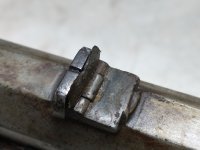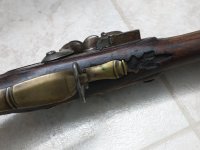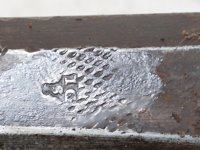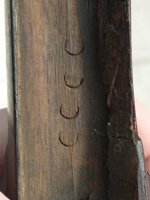I know this is technically outside the scope of this section, but we've used it as a substitute forum for per-unification German arms from time to time given the interests of the guys here.
I picked up a very interesting flintlock Jäger rifle recently and thought some folks might want to see it. Especially given its likely tie to a famous unit and probable participation in the Napoleonic wars.
First, a big thanks to my friend Vincent / Spartaner545 for his considerable assistance with identifying this piece through his connections. This rifle came from a US seller, but I was able to see an old UK listing for it.
I'd been casually looking for a nice flintlock jäger for some time, as I dabble as far back as the late 1700s in my interests. This one popped up for sale and while it had several German characteristics (general look and feel, Suhl style trigger-guard, etc..), it did not have the typical German rear sling swivel. Upon closer inspection of the photos, there was also a British "storekeeper's mark" on the stock. (Crossed swords, a crown and GR cypher).
After consulting with Vincent, he reached out to one of his contacts who indicated it was very likely King's German Legion (KGL)-- An all-German unit within the British Army (Basically the Hannoverian army in exile after their defeat; the two states were in personal union at the time through George III) The KGL has the distinction of being the only German unit to fight continuously against the French, having never surrendered to them. The KGL paricipated and fought bravely in many campaigns (including the Penninsula and Waterloo and had a very good reputation for fighting ability) The traditions of former KGL regiments were carried forward upon Hannover's reconstitution and later absorption into Prussia.
The British connection certainly explains the Storekeeper's mark (and another GR cartouche on the wrist), and the similar sling provision as a Baker Rifle (British jäger clone)
As to the origins of the rifle, upon disassembly, Vincent was able to identify a maker's mark for an unidentified gunsmith in Zella-St. Blasii. I'm not sure if this was a civilian rifle for a volunteer jäger, or possibly a military procurement for Hannover. There are a few decorative embellishments on the screws and lockplate that would likely have been added after military service.
The SN on the barrel, according to VIncent was to pair the rifle to a Hirschfanger bayonet, as they were hand fitted.
The rifle shows its age with several repairs to the stock and the lockplate is quite worn, but it's a true survivor.
In any case, here are the pics. Sorry for the divergence from our normal discussion, but thought it would be of interest.
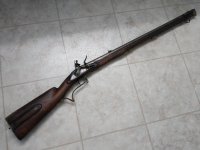



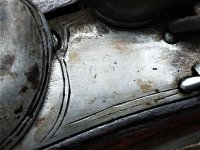
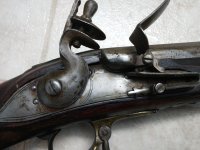



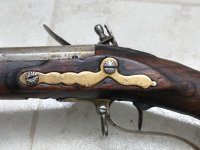
I picked up a very interesting flintlock Jäger rifle recently and thought some folks might want to see it. Especially given its likely tie to a famous unit and probable participation in the Napoleonic wars.
First, a big thanks to my friend Vincent / Spartaner545 for his considerable assistance with identifying this piece through his connections. This rifle came from a US seller, but I was able to see an old UK listing for it.
I'd been casually looking for a nice flintlock jäger for some time, as I dabble as far back as the late 1700s in my interests. This one popped up for sale and while it had several German characteristics (general look and feel, Suhl style trigger-guard, etc..), it did not have the typical German rear sling swivel. Upon closer inspection of the photos, there was also a British "storekeeper's mark" on the stock. (Crossed swords, a crown and GR cypher).
After consulting with Vincent, he reached out to one of his contacts who indicated it was very likely King's German Legion (KGL)-- An all-German unit within the British Army (Basically the Hannoverian army in exile after their defeat; the two states were in personal union at the time through George III) The KGL has the distinction of being the only German unit to fight continuously against the French, having never surrendered to them. The KGL paricipated and fought bravely in many campaigns (including the Penninsula and Waterloo and had a very good reputation for fighting ability) The traditions of former KGL regiments were carried forward upon Hannover's reconstitution and later absorption into Prussia.
The British connection certainly explains the Storekeeper's mark (and another GR cartouche on the wrist), and the similar sling provision as a Baker Rifle (British jäger clone)
As to the origins of the rifle, upon disassembly, Vincent was able to identify a maker's mark for an unidentified gunsmith in Zella-St. Blasii. I'm not sure if this was a civilian rifle for a volunteer jäger, or possibly a military procurement for Hannover. There are a few decorative embellishments on the screws and lockplate that would likely have been added after military service.
The SN on the barrel, according to VIncent was to pair the rifle to a Hirschfanger bayonet, as they were hand fitted.
The rifle shows its age with several repairs to the stock and the lockplate is quite worn, but it's a true survivor.
In any case, here are the pics. Sorry for the divergence from our normal discussion, but thought it would be of interest.












